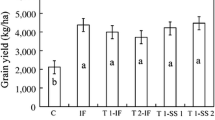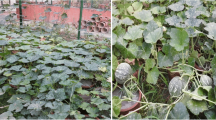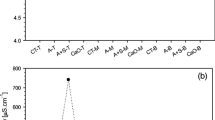Summary
French bean (Phaseolus vulgaris cv. Redland Pioneer) and Rhodes grass (Chloris gayana cv. Pioneer) were grown in glasshouse experiments to examine the potential for phytotoxicity of B in a range of Australian fly ashes. In each experiment, the ashes used were either untreated, leached or adjusted to pH 6.5 and subsequently leached.
In the first eperiment, the yield and B status of plants grown on five fly ashes mixed (5 and 10% by weight) with an acid-washed sand were measured and, with the exception of one ash, yield differences among ash sources and among ash treatments were attributed to differences in the degree of B toxicity. In a subsequent experiment, a fly ash with properties representative of most Australian ashes was mixed (0, 15, 30, 70 and 100% by weight) with a sandy loam, and the yield and mineral composition of plants grown on these mixtures determined. Although the available water capacity of the soil was substantially increased by fly ash addition, incorporating large proportions of untreated fly ash resulted in poor plant growth primarily due to B toxicity. In both experiments, leaching the ash reduced the potential for B toxicity, whereas adjustment of the pH to 6.5 and subsequent leaching of the fly ash resulted in plants with normal levels of B.
There were marked differences in both the tissue levels of B and the extent of B toxicity symptoms between the two species. Rhodes grass appeared to be able to tolerate higher B contents in the growing medium by taking up much less of the element than French bean. The results indicate that phytotoxicity of B would be a major problem in establishing vegetation on ash dams and in the agronomic utilization of unweathered fly ashes in Australia.
Similar content being viewed by others
References
Adriano D C, Woodford T A and Ciravolo T G 1978 Growth and elemental composition of corn and bean seedlings as influenced by soil application of coal ash. J. Environ. Qual. 7, 416–421.
Aitken R L and Bell L C 1984 The effectiveness of fly ash as a liming material on some acidic soils. Proceedings National Soils Conference, Brisbane, Australia, Aust. Soc. Soil Sci. p. 313.
Aitken R L, Campbell D J and Bell L C 1984 Properties of Australian fly ashes relevant to their agronomic utilization. Aust. J. Soil Res. 22, 443–453.
Andren A W, Klein D H and Talmi Y 1975 Selenium in coal-fried steam plant emissions. Environ. Sci. Tech. 9, 856–858.
Bresler E, McNeal B L and Carter D L 1982 Saline and Sodic Soils. Springer-Verlag, Berlin.
Campbell D J, Fox W E, Aitken R L and Bell L C 1983 Physical characteristics of sands amended with fly ash. Aust. J. Soil Res. 21, 147–154.
Collier G F and Greenwood D J 1977 The influence of solution concentration of aluminium, arsenic, boron and copper on root growth in relation to the phytotoxicity of pulverised fuel ash. J. Sci. Food Agric. 28, 145–151.
Cope F 1962 The development of a soil from an industrial waste ash. Trans. Int. Soc. Soil Sci. Comm. IV and V. Palmerston North, New Zealand Soil Science and Society pp 859–863.
Cox J A, Lundquist G L, Przyjazny A and Schmulbach C D 1978 Leaching of boron from coal ash. Environ. Sci. Technol. 12, 722–723.
Doran J W and Martens D C 1972 Molybdenum availability as influenced by application of fly ash to soil. J. Environ. Qual. 1, 186–189.
Elseewi A A, Bingham F T and Page A L 1978 Availability of sulphur in fly ash to plants. J. Environ. Qual. 7, 69–73.
Furr A K, Kelly W C, Bache C A, Gutenmann W H and Lisk D J 1976 Multielement uptake by vegetables and millet grown in pots on fly ash amended soil. J. Agric. Food Chem. 24, 885–888.
Geraldson C M, Klacan G R and Lorenz O A 1973 Plant analysis as an aid in fertilizing vegetable crops.In Soil Testing and Plant Analysis. Eds. L M Walsh and J D Beaton. Soil Sci. Soc. Am. Madison, Wisc. pp 365–379.
Gupta U C 1979 Boron nutrition of crops.In Advances in Agronomy 31, 273–307.
Hill M F and Lamp C A 1980 Use of pulverised fuel ash from Victorian brown coal as a source of nutrients for a pasture species. Aust. J. Exp. Agric. Anim. Husb. 20, 377–384.
Hodgson D R and Holliday R 1966 The agronomic properties of pulverised fuel ash. Chem. and Ind., pp. 785–790.
Hodgson D R and Townsend W N 1973 The melioration and revegation of pulverised fuel ash.In Ecology and Reclamation of Devastated Land Vol. II. Eds R J Hutrick and G Davis. Gordon and Breach, New York pp 247–271.
Jones J B 1972 Plant tissue analysis for micronutrients.In Micronutrients in Agriculture. Eds. J J Mortvedt P M Giordano and W L Lindsay Soil Sci. Soc. Am. Madison, Wisc. pp 319–346.
Moliner A M and Street J J 1982 Effect of fly ash and lime on growth and composition of corn (Zea mays L.) on acid sandy soils. Soil Crop Sci. Soc. Fla. 41, 217–220.
Mulford F R and Martens D C 1971 Response of alfalfa to boron in fly ash. Soil Sci. Soc. Am. Proc. 35, 296–300.
Phung H T, Lund L J, Page A L and Bradford G R 1979 Trace elements in fly ash and their release in water and treated soils. J. Environ. Qual. 8, 171–175.
Plank C O and Martens D C 1974 Boron availability as influenced by application of fly ash to soil. Soil Sci. Soc. Am. Proc. 38, 974–977.
Plass W T and Capp J P 1974 Physical and chemical characteristics of surface mine spoil treated with fly ash. J. Soil Water Con. 29, 119–121.
Robets F J 1966 The effects of sand type and fine particle amendments on the emergence and growth of Subterranean clover (Trifolium subterraneum L.) with particular reference to water relations. Aust. J. Agric. Res. 17, 657–672.
Romney E M, Wallace A and Alexander G V 1977 Boron in vegetation in relationship to a coal-burning power plant. Commun. Soil Sci. Pl. Anal. 8, 803–807.
Russell J S 1976 Comparative salt tolerance of some tropical and temperate legumes and tropical grasses. Aust. J. Exp. Agric. An. Husb. 16, 103–109.
Wear J I 1965 Boron.In Methods of Soil Analysis, part 2. Ed. C A Black. Am. Soc. Agron. Madison, Wisc. pp. 1062–1063.
Author information
Authors and Affiliations
Rights and permissions
About this article
Cite this article
Aitken, R.L., Bell, L.C. Plant uptake and phytotoxicity of boron in Australian fly ashes. Plant Soil 84, 245–257 (1985). https://doi.org/10.1007/BF02143187
Received:
Revised:
Issue Date:
DOI: https://doi.org/10.1007/BF02143187




